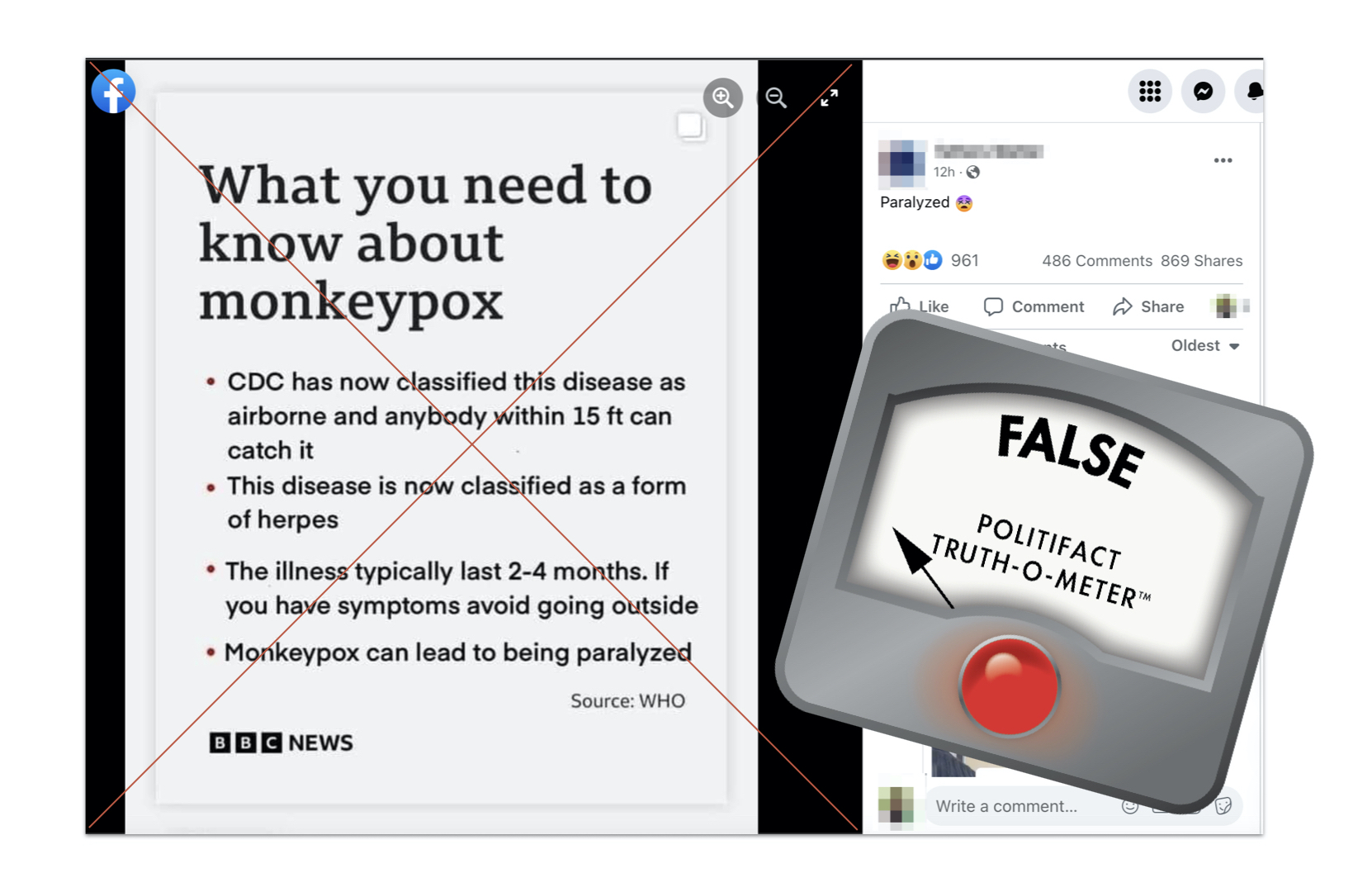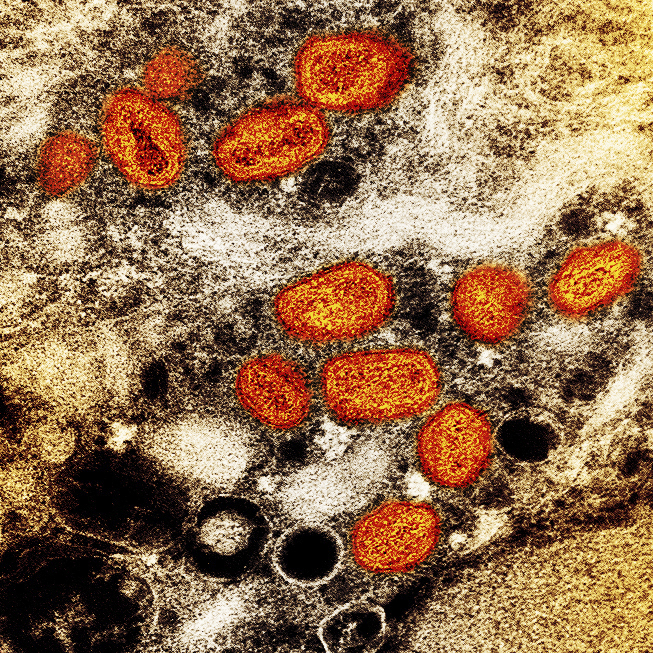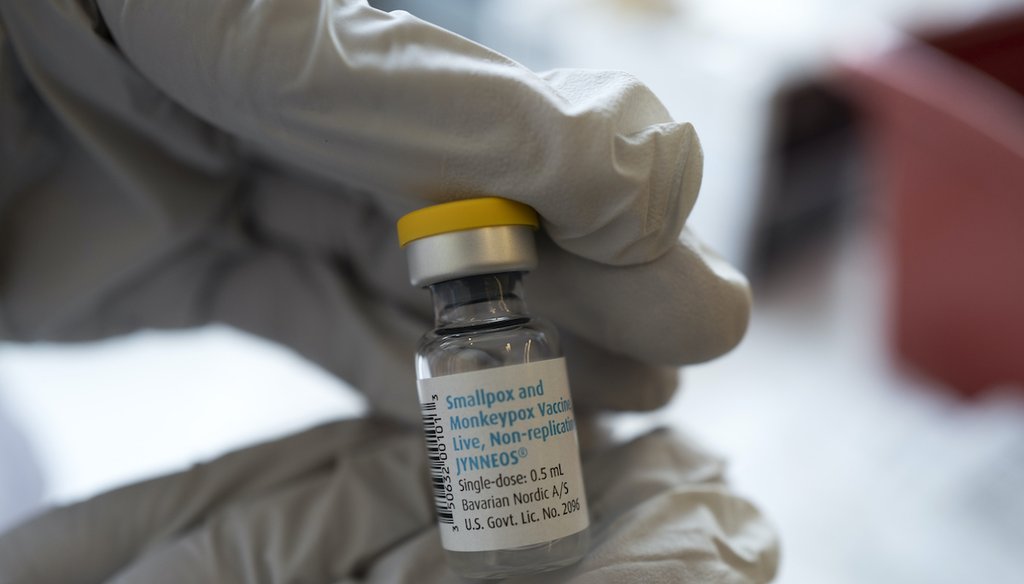

Our only agenda is to publish the truth so you can be an informed participant in democracy.
We need your help.


Registered pharmacist Sapana Patel holds a bottle of monkeypox vaccine at a pop-up monkeypox vaccination site on Aug. 3, 2022, in West Hollywood, Calif. (AP)
Monkeypox spreads primarily through close physical contact, including direct contact with monkeypox rash. There’s no evidence the CDC classifies it as "airborne" or has said it can spread to people who are 15 feet away from someone who is infected.
Monkeypox symptoms typically last two to four weeks, according to the World Health Organization and CDC.
The disease is not classified as a form of herpes, and the WHO does not list paralysis as a complication of severe monkeypox cases.
The Biden administration declared monkeypox a public health emergency on Aug. 4, but leading national and international health organizations haven't made sweeping changes to the way they classify the virus and illness, despite alarming claims made by an image circulating online.
An image shared in a Facebook post on Aug. 3 suggested that the Centers for Disease Control and Prevention and the World Health Organization made major changes to their available monkeypox guidance and information.
The screenshot (embedded below) purports to be from a BBC News article and features its logo. A headline reads, "What you need to know about monkeypox," and makes the following claims:
CDC has now classified this disease as airborne and anybody within 15 ft can catch it
This disease is now classified as a form of herpes
The illness typically last 2-4 months. If you have symptoms avoid going outside
Monkeypox can lead to being paralyzed
The post was flagged as part of Facebook’s efforts to combat false news and misinformation on its News Feed. (Read more about our partnership with Facebook.)

(Screenshot from Facebook.)
The BBC confirmed the image was not a real graphic and urged people to check the veracity of stories on the BBC News website.
A search for the screenshot’s headline on the BBC News website turned up no matching results. On Aug. 2, BBC News published a story about monkeypox with the headline, "What is monkeypox and how do you catch it?"
The article cites the World Health Organization and the UK Health Security Agency and doesn’t make any of the claims shared in the screenshot.
In addition, reverse image searches for the purported screenshot on Google Image, TinEye, Bing and Yandex returned no matching results. Searches for the exact phrases shared in the image also returned no results, further demonstrating that the image is fake and was not shared by BBC News.
Amid the current outbreak, some monkeypox questions are still being researched. But available information contradicts the points made in the screenshot.
First, monkeypox does not spread through the air. It is a rare disease caused by infection of the monkeypox virus, according to the CDC.
It spreads from person to person "through close contact with someone who has a monkeypox rash, including through face-to-face, skin-to-skin, mouth-to-mouth or mouth-to-skin contact," the WHO reported. This includes sexual contact.
Monkeypox can spread through direct contact with monkeypox rash, scabs or bodily fluids from someone infected with the virus; touching objects, fabrics and surfaces that someone with monkeypox has used; and contact with respiratory secretions, according to the CDC. Someone who is pregnant can spread the virus to the fetus through the placenta, and people can also get monkeypox from infected animals.
There’s no evidence the CDC classifies monkeypox as airborne or has said it can spread to people who are 15 feet away from someone who is infected.
"Airborne transmission occurs when small virus particles become suspended in the air and can stay there for periods of time," the CDC said. "These particles can spread on air currents, or sometimes even infect people who enter a room after the infected person has left. In contrast, monkeypox may be found in droplets like saliva or respiratory secretions that drop out of the air quickly."
Airborne transmission of monkeypox has not been reported, the CDC said in June.

This image provided by the National Institute of Allergy and Infectious Diseases (NIAID) shows a colorized transmission electron micrograph of monkeypox particles (orange) found within an infected cell (brown), cultured in the laboratory. (NIAID via AP)
Second, and contrary to the content in the fake image, monkeypox is not a form of herpes. The disease is caused by the monkeypox virus, which is a member of the Orthopoxvirus genus, the WHO reported. Genital herpes, meanwhile, is a sexually transmitted disease caused by two types of viruses: herpes simplex virus type 1 and herpes simplex virus type 2, according to the CDC. Monkeypox is "not considered a sexually transmitted infection," according to the CDC’s monkeypox FAQ page.
The WHO says that "while close physical contact is a well-known risk factor for transmission, it is unclear at this time if monkeypox can be transmitted specifically through sexual transmission routes. Studies are needed to better understand this risk."
Third, monkeypox does not typically last two to four months. The WHO and CDC report that symptoms typically last about two to four weeks.
Finally, the WHO does not list paralysis as one of the main complications of severe monkeypox cases.
Some severe cases of infection can lead to medical complications including secondary infections, pneumonia, sepsis, encephalitis, confusion and infection of the cornea, which can cause vision loss, the WHO reported. Historically, between 1% and 10% of people with monkeypox have died.
Monkeypox can also cause encephalitis, or the inflammation of the brain, which can sometimes cause severe symptoms, including seizures, memory problems, personality changes, paralysis and hearing or vision problems, according to Mayo Clinic.
A fake BBC News screenshot claims the CDC has classified monkeypox as an airborne form of herpes that typically lasts two to four months and can lead to paralysis.
The CDC and WHO haven’t changed how they classify monkeypox. The virus does not spread primarily through airborne transmission, is not a form of herpes, does not last two to four months and rarely leads to paralysis. Also, the image posted on Facebook is not a real graphic shared by BBC News.
We rate this claim False.
Facebook post, Aug. 3, 2022
BBC News, accessed Aug. 4, 2022
BBC News, "What is monkeypox and how do you catch it?" Aug. 2, 2022
BBC News statement provided Aug. 4, 2022
The Washington Post, "Understanding monkeypox and how outbreaks spread," Aug. 4, 2022
Centers for Disease Control and Prevention, "About Monkeypox," accessed Aug. 4, 2022
Centers for Disease Control and Prevention, "How it spreads - monkeypox," accessed Aug. 4, 2022
World Health Organization, "Monkeypox," May 19, 2022
World Health Organization, "Monkeypox Q&A," July 12, 2022
Centers for Disease Control and Prevention, "CDC monkeypox response: transmission," June 9, 2022
Centers for Disease Control and Prevention, "Genital Herpes – CDC basic fact sheet," accessed Aug. 4, 2022
Centers for Disease Control and Prevention, "Signs and symptoms - monkeypox," accessed Aug. 4, 2022
Mayo Clinic, "Encephalitis," accessed Aug. 4, 2022
In a world of wild talk and fake news, help us stand up for the facts.
